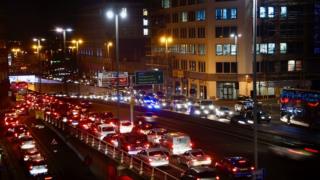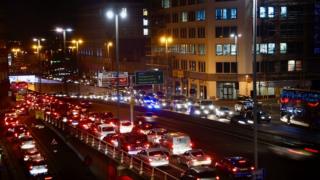Birmingham car ban: How would the scheme work?
A scheme to stop cars travelling across the city has been proposed, but how would it actually work? …


A plan to ban car drivers from taking trips across Birmingham city centre has raised questions about taxis, commuting, electric vehicles and emergencies. So how would it actually work?
What is the plan?
Birmingham City Council wants to cut air pollution by allowing cars to travel into the city but not through it.
Under the proposals, drivers entering the centre would have to go back out to the ring road to then get to other areas.
Our story, which outlined the Birmingham Transport Plan 2031, prompted hundreds of readers to get in touch to ask how the changes would impact on specific drivers and circumstances.
Most of these details were not included in the plan as it was a “draft vision document subject to consultation”, a council spokesman said.
Here is how we got on with answering your questions.
What does it mean for commuters?
Commuter car parking will be limited in areas like the city centre that are well served by public transport, according to the document.
“Buses, trams and trains will be the backbone of a new, go-anywhere transport system,” it said.
“Sprint [bus] services will deliver high-frequency services on main commuter routes with predictable journey times and dependable timetables,” the plan stated.
There will be seven routes and three of them will be in place for the Birmingham 2022 Commonwealth Games.
- A34 Walsall to Birmingham
- A45 Birmingham City Centre to Birmingham Airport and Solihull
- Sutton Coldfield to Birmingham via Langley (SBL)
What about taxis?
The only mention of taxis in the plan said those “that meet emissions standards will also make a valuable contribution to the integrated transport system”.
Birmingham’s licensing and public protection committee had already approved new policies to regulate the number and type of taxis and private hire vehicles it will licence from January 2020, it said.
The council’s website said it had funding for 197 charging points for electric and hybrid taxis and private hire vehicles in about 80 locations.
These will start being installed this year in the city centre, at Tyseley Energy Park and at a number of locations around the outer circle, it said.
What about electric cars?
The plan said: “Irrespective of advancements in technology, single occupancy private cars will never be able to match the capacity of mass public transport for getting people to where they want to go.”
On-street parking spaces would be prioritised for “sustainable forms of transport”, it said.
The council plans to replace its 36 public electric car charging points with rapid chargers in more locations starting in early 2020, according to its website.
What about ambulances and people getting to hospital?
Hospital trips or emergency services vehicles were not specifically mentioned in the plan.
However, as the plan prohibits only cross-city trips, patients would be able to drive to a hospital and leave again via the ring road.
Patients would not be able to drive across the city to get to a hospital on the other side, they would have to go around.
What about drivers with disabilities?
Any decisions over how the plan was rolled out would take into account the needs of motorists with disabilities, the plan said.
The number of disabled parking bays in easily accessible locations would be protected wherever possible, according to the document.
On-street parking spaces would be prioritised for people with disabilities, cyclists, car clubs and other sustainable forms of transport.
“Mobile apps could make it easier, particularly for people with disabilities, to book and pay for transport with a single transaction supporting journeys that combine several modes,” it said.
How can I give my thoughts on the plan?
The draft plan is due to go to cabinet on 21 January.
If it is approved by councillors it will go out to public consultation on 28 January until 27 March.


